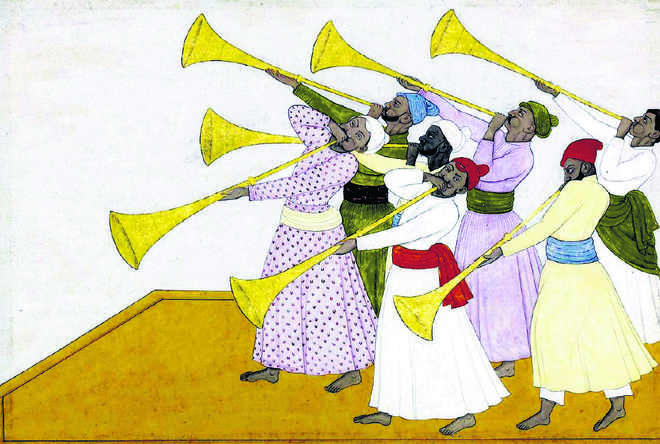Raghav Guleria
A workshop on Guler miniature paintings was conducted in June last year at Nandpur Guler, a historic monument located in Kangra district of Himachal Pradesh, where the last ruler — Raja Baldeo Singh, once lived.
It was wonderful to see this sleepy premise come back to life with nearly 100 students from 15 different schools of the district receiving inputs from notable masters in Pahari School for three days.
Padma Shree Vijay Sharma and his decorated students Mukesh Dhiman and Dhani Ram not only shared their experience with participating students, but also wrote permanent artistic impressions on the weary walls of the monument.
The interactive sessions in the evening unfolded many details of this art form, which gave a fair idea of its richness, much appreciated globally, but sadly bereft of any local patronage. Students fared well and the event culminated as a tribute to a painting style, which once flourished in Guler before its expansion to other neighbouring hill states.
Coming from Guler lineage and having remained closely associated with the conservation of many tangibles and intangibles over 30 years, especially the ongoing restoration of the red brick castle overlooking the mighty Pong Lake, I had not visualised the bandwidth of this art form. In the remotest of my dreams, I could never ever think of all that has now come as a big surprise to me.
Three stalwarts on job
Recently, filmmaker Amit Dutta visited Guler with his crew looking for the reminiscences of this principality, which once flourished in all its tranquil fertility. Well-versed with Guler’s strength as an outstanding contributor in the field of art and culture, I found in him a true well-wisher for this region otherwise left to the mercy of winds. He had already researched the subject and I was surprised to see his emotional bonding with the place, which I have breathed all these years.
The research and subsequent publication of books by BN Goswamy and Eberhard Fischer has brought to light the great contribution made by Pandit Seu and his illustrious sons — Manaku and Nainsukh. The world-wide appreciation earned by the trio is a relatively recent revelation, at least for us. Sadly, our institutions seem to have no appreciation for these legends and there is hardly any awareness about their invaluable contribution. Fortunately one family lineage — Anil Raina, direct descendant of the illustrious Nainsukh, who lives near Gaggal — is still practising this art in the region.
The real credit for getting a centre stage for this remarkable Chitera Gharana goes to BN Goswamy, whose untiring passion has finally earned a befitting place for these outstanding artists. His book Nainsukh of Guler — A great Indian painter from a small hill state, published in 1997, proves his academic excellence. Popular as BNG among his associates, his relentless passion has earned him a Padma Shree and Padma Bhushan.
Finally, justice has been done to these sons of the soil forgotten since times immemorial. Goswamy’s tireless efforts discovered Nainsukh in the bahi (record) of Haridwar, where this hero lies buried in those nine beautiful lines written in his own hand, dating back to 1763. This discovery has given a fresh lease of life to this entire subject, which was lost for the want of a genuine record.
In Eberhard, we find an art anthropologist, whose connection with India for over four decades, climaxed in the making of the film ‘Nainsukh’ — a true tribute to the forgotten hero. Amit Dutta, a graduate from FTII, honoured with many national and international awards for his relentless efforts in experimental film-making, has succeeded in recreating the lost vibes. His creativity using cinema as a medium to showcase the painter’s life is commendable. He has done justice to his work within limited resources. These three stalwarts have proved that passionate thinking, writing and producing can work wonders.
Admired world over
The remarkable admiration “Nainsukh” received in the film festivals held world over especially at Venice, Beijing, Rotterdam and San Francisco is unparalleled. ‘Trumpeters,’ a Nainsukh painting of rare calibre, was in the news in November 2018, as it was to be auctioned in England for around 550,000 Pounds. Subsequently, it was cancelled as the government of England wished to retain it for further study. Sunil Khilnani’s book Incarnations - India in 50 Lives, which begins with Mahatma Buddha, Mahavira and Aryabhata includes just one Himachali — Nainsukh of Guler.
The comprehensive study and the popularity of the movie has given proud moments to Himachal and Guler in particular, which is yet to settle down after the massive dislocation in the early ’70s. It is high time the government comes forward and preserves this rich art.
The origin of Kangra miniature paintings
It is a well-established fact now that the world-renowned Kangra miniature paintings originated in Guler in the early 18th Century under the benevolent patronage of the then rulers. It is hard to believe as to how this small principality with meagre resources could extend such patronisation in the field of art and literature. Innumerable temples, forts, gateways, wells and ponds here stand as a testimony to the grandeur of this hill state carved out of Kangra 600 years ago. The ones who have lived those thriving moments narrate the prosperity of this valley, where every inch of the land was irrigated by a wonderful network of water channels. People would only need kerosene and salt from the outside world. Chandradhar Sharma Guleri’s ‘Usne Kaha Tha’ and other literature of noted scholars including Kavi Brajraj’s ‘Ramras Lahiri’ or Uttam Kavi’s ‘Dalip Ranjini’ of mid-eighteenth Century are precious treasures. These literary marvels mirror the lifestyle of the 18th and 19th Centuries in the hills.
(The author teaches management students in Dharamsala and has keen interest in conservation works in Guler)
Unlock Exclusive Insights with The Tribune Premium
Take your experience further with Premium access.
Thought-provoking Opinions, Expert Analysis, In-depth Insights and other Member Only Benefits
Already a Member? Sign In Now











